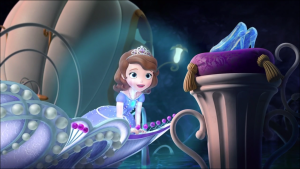On October 12th, Sofia the First aired “The Secret Library,” an episode featuring an obvious secret library and a not-so-obvious secret river with depicted Disney “realms.” These Disney “realms” showcase worlds inhabited by Disney Princesses—Cinderella’s fairy tale castle, Merida’s misty cliffs, and Tiana’s New Orlean bayou, among others. These Disney “realms,” whimsical though they are, illustrate a very problematic concern with cultural representation.
So what do these “realms” have to do with cultural representation?
Quite a bit, actually.
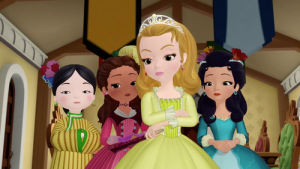
You see, Sofia, a plucky sweet thing, becomes a princess in the first episode, when her mother marries the King of Galdiz; this elevation to royal status officially made her Disney’s first Latina Princess—accidentally. It seems that on the press tour, a producer misspoke in identifying Sofia as Latina. Disney Junior Worldwide general manager Nancy Kanter clarified that Sofia’s nation of Galdiz is based upon Spain, much like how Frozen’s Arendelle has Scandinavian inspiration. “What’s important to know is that Sofia is a fairytale girl who lives in a fairytale world,” Kanter wrote. Co-executive producer Craig Gerber echoed this thought, adding that the country Enchancia is a “make-believe ‘melting pot’ kingdom patterned on the British Isles.” This “melting pot kingdom” incorporates many cultures and races, as evidenced by the Princesses and by Sofia’s friends (if not by Sofia herself). Sofia’s mother has a noticeably darker skin tone than Sofia, and Sofia’s birth father has been identified as being from a Scandinavia-ish country.
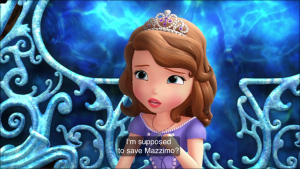
Okay, so Sofia is vaguely…European, in a vaguely…European country.
This move isn’t new for Disney; princesses from Snow White to Ariel to all inhabit vaguely European countries. Recently, princesses such as Rapunzel, Elsa, and Anna inhabit European-esque kingdoms that are named, such as Rapunzel’s Corona and Elsa and Ana’s Arendelle. That said, however, many Disney princesses also roost in worlds recognizable as our own: Mulan’s China, Belle’s France, Tiana’s New Orleans, etc. And on Sofia the First, princesses from all of these “realms” appear to give her advice, regardless of kingdom (or world) origin.
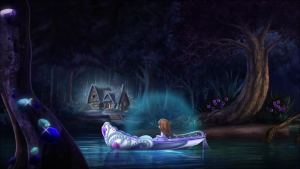
And as apparent from “The Secret Library” episode, Sofia the First will likely continue exploring princesses from our distinct world. In the episode, Sofia, in a wee sparkly boat that would not look amiss in any Barbie aisle, passes through “mini-realms” that represent different Disney worlds. First she passes through Snow White’s realm, represented through wishing well, dwarf cottage, and sparkling un-mined gems. Then on she goes to Cinderella, with an elongated staircase, silver pumpkin-carriage, and glass slippers perched atop an altar (interestingly, that’s how these “realms” felt: less like portals and more like altars, Disney shrines to its successes). Sofia then passes through many mini-realms: the obligatory Frozen tree icicles, cherry blossoms for Mulan, a shot of a Virginia river and ship for Pocahontas.
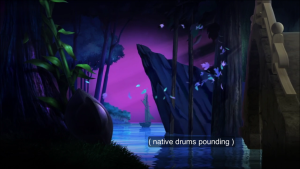
It’s the inclusion of the latter that I’m most intrigued by. Mulan and Tiana (both inhabiting a world-more-ours-than-fiction) have both appeared on Sofia the First, but viewers have yet to see Pocahontas, which suggests that she could soon be making an appearance—yet another appearance by a princess occupying a world very different from Sofia’s Galdiz or Enchancia.
Which opens up the question, if this is an avenue Disney is exploring anyway, why couldn’t Sofia actually have been a Latina princess? Jasmine has a distinct Middle-Eastern heritage in a kingdom impressed with a distinct Middle-Eastern culture (which is apt for a retelling of Arabian Nights, after all). Couldn’t Sofia’s story be told similarly? Or another option could be for Sofia to operate within a fictional Spain, much like Pocahontas operates with a fictional, rewritten history of Virginia. Or at the very least, since Elsa and Anna look markedly Scandinavian, couldn’t Sofia have looked markedly Latina or Hispanic?
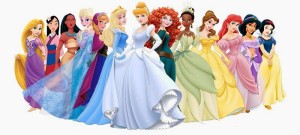
Now, nothing against white, blue-eyed, brunette girls (I am one), and I applaud Disney Junior for its approach in portraying both multicultural and blended families. But representation is a serious issue, especially in an industry that has minority princesses in, well, the minority. We have the Cinderella-Aurora-Rapunzel-Elsa squadron of Caucasian blondes, tied in the lead with the Ariel-Anna-Merida-Giselle Caucasian redheads. And then we have a smattering of princesses, Mulan-Jasmine-Tiana-Pocahontas, which are representative of individual cultures. Disney’s representation of racial identity is a serious issue, and although cultural representation in recent years is improving, the sheer dichotomy between Caucasian representation and non-Caucasian representation casts the non-Caucasian as “the Other,” which is a terrible message for viewing youngsters. Add in the fact that Sofia’s Scandinavian-ish birth father is absent from the series and thus contributes nothing to the multicultural family sphere, and Sofia’s vaguely European look smells suspiciously like a cop-out.
C’mon, Disney. Give girls their Latina princess.
